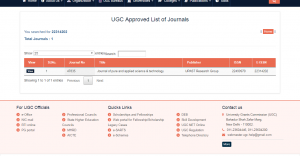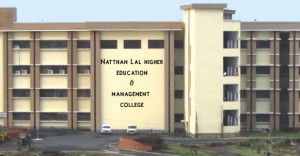Comparative Structural Analysis of PBZT Nanoceramics Synthesized by Co-precipitation and Sol-gel Method – Pradeep Kumar Yadav, Amar Pal and Sanjay Kumar Singh.
Comparative Structural Analysis of PBZT Nanoceramics Synthesized by Co-precipitation and Sol-gel Method
Pradeep Kumar Yadav1,*, Amar Pal2 and Sanjay Kumar Singh3
1Physics Department, Meerut College, Meerut (U.P) India
2Sanskar College of Engg. & Tech., Ghaziabad (U.P.) India
3Directorate of Higher Education, U.P. Allahabad, India
*email: yadav62pk@gmail.com
In this study, a comparative structural analysis of bismuth doped PZT nanoceramics (i.e. Pb0.98 BI0.02 (Zr0.52 TI0.48)0.98 O3) prepared by chemical co-precipitation and sol-gel methods has been made. Perovskite PZT phase in the compound prepared by sol-gel method can be seen ta the temperature as low as 250°C whereas the evolution of PZT phase along with small amount of pyrochlore phase take place only after 400°C temperature in the samples prepared by co-precipitation method. The X-Ray diffractogram of pellets sintered at 1100°C also confirms that bismuth doping does not affect the crystal structure of the compounds and a tetragonal unit cell structure was formed in both of the cases.
Keywords: Nanoceramics, PZT, Sol-gel, XRD.
 Full Paper
Full Paper
Study of Chemically Synthesized Nanocomposite Copolymer of N-Methyl Pyrrole and 2,5-Dimethoxy Aniline – Rajeev Rathore, Ajay Chauhan and Pradeep Kumar Yadav.
Study of Chemically Synthesized Nanocomposite Copolymer of N-Methyl Pyrrole and 2,5-Dimethoxy Aniline
Rajeev Rathore1,*, Ajay Chauhan2 and Pradeep Kumar Yadav2
1,*Chemistry Department, Meerut College, Meerut-250002 (U.P) India
2Physics Department, Meerut College, Meerut-250002 (U.P) India
1,*email: r.rathore_@hotmail.com
Copolymer nanocomposite of N-Methyl pyrrole (NMPy) and 2,5-dimethoxy aniline (DMOA) doped with HCl was synthesized using chemical oxidative polymerization. Ammonium persulfate (APS) was used as an oxidant. The nanocomposite samples were characterized for structural configurations by UV-Vis, FTIR, TGA and XRD. Four probe method was adopted for the measurement of electrical conductivity. Spectroscopy confirms the p-p* transition in nanocomposite copolymer. FTIR confirms the formation of copolymer and its structure. XRD analysis shows the amorphous nature of polymer nanocomposite. The electrical conductivity of sample was comparable to the intrinsic conductive polymers used. Size and surface morphology was demonstrated by SEM.
Key words: Nanocomposite, copolymer, XRD, TGA, SEM, four probe method.
 Full Paper
Full Paper
Effects of Space Weather due to Solar Radiation on High Frequency Communication Technologies – Sanjay Kumar Singh, Anil Kumar and Ajay Chauhan.
Effects of Space Weather due to Solar Radiation on High Frequency Communication Technologies
Sanjay Kumar Singh1, Anil Kumar2 and Ajay Chauhan3,*
1,2Physics Department, OPJS University, Rajgarh, Churu, Rajasthan, India.
3,*Physics Department, Meerut College, Meerut, U. P., India.
email: cajaymcm@gmail.com
The effects of Space Weather on technology are manifold and can be experienced in deep space as well as on the surface of the earth. Space weather effecting prevalent technologies on earth are primarily linked to the conditions in space environment, predominantly controlled by the Sun. This article describes the basic facts for understanding processes responsible for space weather effects on (i) satellites, (ii) power systems, (iii) radio propagation, (iv) communication cables and few other technologies. The events under this study are associated with CME’s, flares, particle radiations and plasmas of solar origin.
Keywords: Space weather, Satellites, Solar flares, Plasmas of solar origin.
 Full Paper
Full Paper
Study of Bandwidth of Airgap Circular Patch Microstrip Antenna (CPMA) in S and X Band – Dr. Sandhya Mann.
Study of Bandwidth of Airgap Circular Patch Microstrip Antenna (CPMA) in S and X Band
Dr. Sandhya Mann
Assistant Professor, Department of Physics, Agra College, Agra, U.P., India.
Microstrip antennas have received a lot of attention in the recent years because of their potential applications in many portable communication systems. There has been significant advancement in improving the inherent narrow operating bandwidth of microstrip antennas. Use of air gap between the substrate and the ground plane is an effective and convenient approach for improving the band width. Hence, in this paper an attempt has been made to study and develop a broad band microstrip antenna by creating an air gap between the ground plane and the dielectric substrate. The analysis has been done on a circular patch in microwave frequencies range of S and X band. Effect of air gap on band width has been studied and plotted. This can conveniently be applied to the array configuration of any geometry for much larger band gap achievement.
Keywords : Microstrip antennas, Bandwidth, Airgap circular patch.
 Full Paper
Full Paper
The Study of HTS Conduction Processes in Pure & Doped Y123 Superconductors – Pawan Kumar and Vaibhav Jain.
The Study of HTS Conduction Processes in Pure & Doped Y123 Superconductors
Pawan Kumar1,* and Vaibhav Jain2
1,*Associate Prof., Department of Physics, A.S. (P.G.) College, Sikanderabad, U.P., India.
2Associate Prof., Department of Physics, D.A.V. (P.G.) College, Bulandshahr, U.P., India.
An attempt to enhance the HTS conduction due to doping has been made in Y123. An attempt of resistivity transition in HTS under magnetic field is under trial. Pr – doping in HTS Y123 emerges effective in shifting the superconducting transition temperature in different stages.
Keywords: High Temperature Superconductivity (HTS), Doping, Superconductivity.
 Full Paper
Full Paper






